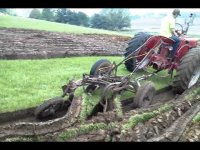Thanks for the explanation, that helps give me a good idea. As far as brome grass, I'm starting to think that maybe a Midwest thing cause you are not the first person who is unfamiliar with it. It kind of grows naturally here along road side and what not. It is kind of hard on the ground (drains the nutrients) so if you want to use it for hay you have to fertilize it every year to get a good hay crop. It has a tremendous root system that sort of spider webs beneath the soil. If you want to plow it under say to plant corn or soybeans it is best to spray it first. When you go to plow the terraces, boy does it pull and beak hard. As far as the grass and hay feature, it depends on how well you fertilized it. Properly fertilized it will be pretty thick and waste high. It make for an excellent choice of hay for cattle. Hope this helps.

